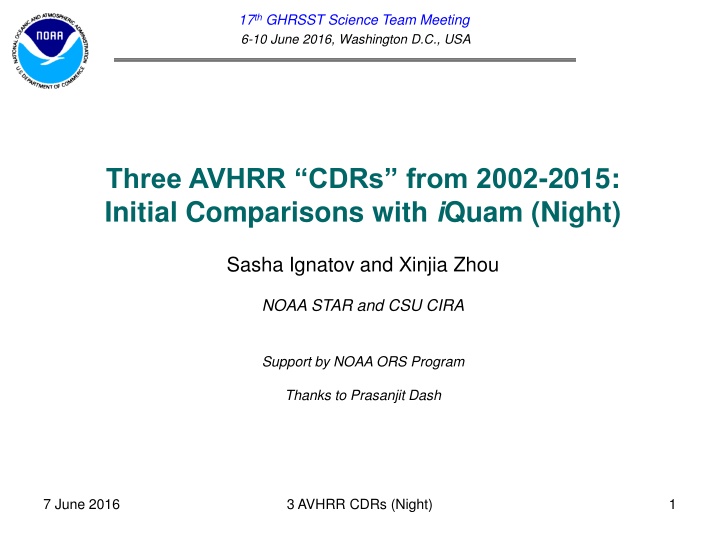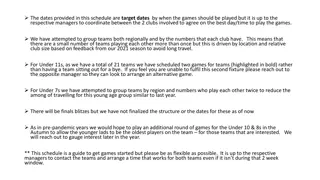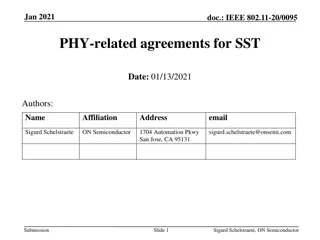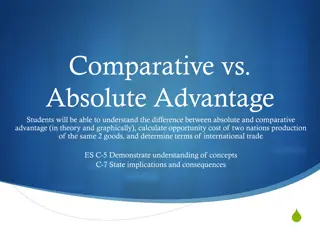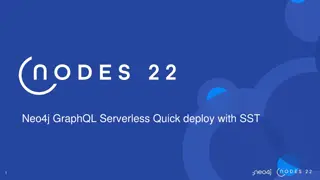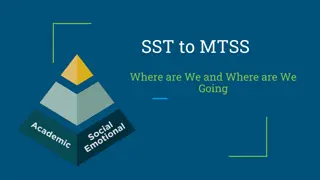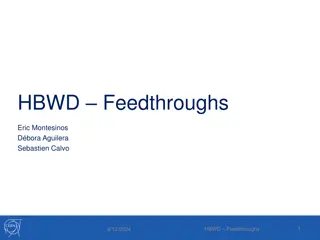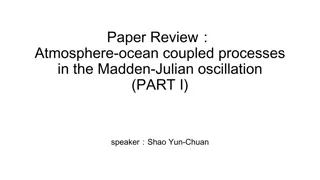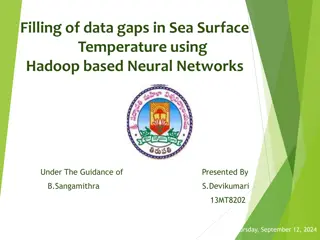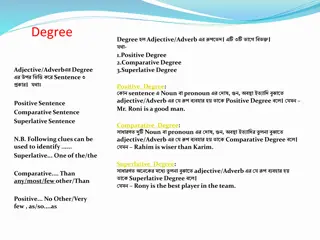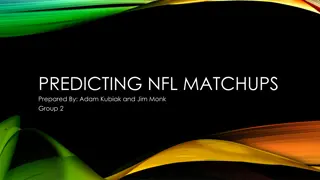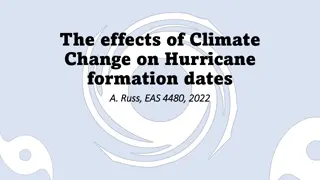Comparative Analysis of AVHRR SST Products and Matchups with iQuam
This document discusses the comparisons and analyses of several AVHRR SST products, such as Pathfinder V5.2 and CCI, with a focus on their matchups against iQuam using drifters and tropical moorings data. It covers biases, number of matchups, and mean bias values, providing insights into the performance and reliability of these products. The study sheds light on the strengths and limitations of AVHRR SST datasets in relation to in-situ observations, offering valuable information for ocean temperature monitoring and analysis.
Download Presentation

Please find below an Image/Link to download the presentation.
The content on the website is provided AS IS for your information and personal use only. It may not be sold, licensed, or shared on other websites without obtaining consent from the author.If you encounter any issues during the download, it is possible that the publisher has removed the file from their server.
You are allowed to download the files provided on this website for personal or commercial use, subject to the condition that they are used lawfully. All files are the property of their respective owners.
The content on the website is provided AS IS for your information and personal use only. It may not be sold, licensed, or shared on other websites without obtaining consent from the author.
E N D
Presentation Transcript
17th GHRSST Science Team Meeting 6-10 June 2016, Washington D.C., USA Three AVHRR CDRs from 2002-2015: Initial Comparisons with iQuam (Night) Sasha Ignatov and Xinjia Zhou NOAA STAR and CSU CIRA Support by NOAA ORS Program Thanks to Prasanjit Dash 7 June 2016 3 AVHRR CDRs (Night) 1
3 long-term AVHRR SST Products Pathfinder V5.2 (PFV5.2) Data available from 1981 2012 Skin SST (a -0.17K bias is expected) Kilpatrick et al, JGR, 2001; Casey et al, 2010; Kilpatrick, CATBD, 2013; CCI Data available from 1991 2010 Skin SST (a -0.17K bias is expected) Merchant et al, Geosci Data J., 2014 AVHRR RAN1 Data available from Jul 2002 Dec 2015 Sub-skin SST (no bias wrt in situ expected) Shown below are SSES bias corrected (Petrenko et al , JTECH 2016; better proxy for depth SST) Ignatov et al, Remote Sens., 2016 Comparison only done for Night, QL=5, from Jul 2002 Dec 2015 6 June 2016 NOAA ACSPO H8 SST 2
With respect to Drifters and Tropical Moorings RAN1 SST_depth (SSES bias corrected) 20 July 2015 SQUAM and iQuam 3
AVHRR RAN1 and PFV5.2: Number of Matchups against iQuam (Drifters + Tropical Moorings) RAN1 reported from 2 satellites (PM & mid-AM) vs. one in PFV5.2 PFV5.2 is only produced through Dec 2012 Number of retrievals with QL=5 is factor of 2 larger in RAN1 RAN1 is a L2 and PF is a L3 (0.04 ) product RAN1: QL=5 retrievals made in full swath (PF: only within VZA<55 ) 7 June 2016 3 AVHRR CDRs (Night) 4
AVHRR RAN1 and CCI: Number of Matchups against iQuam (Drifters + Tropical Moorings) CCI is a L2 product , only produced through Dec 2010 Reported from all available satellites (up to 3-4 satellites at a time) Several months of N15 in 2002 and 1 month of N17 in 2010 omitted Number of CCI QL=5 retrievals is comparable with PFV5.2 QL=5 retrievals made within VZA<55 as in PFV5.2 7 June 2016 3 AVHRR CDRs (Night) 5
AVHRR RAN1 and PFV5.2: Mean Bias against iQuam (Drifters + Tropical Moorings) RAN1 regression coefficients smoothed using moving 45day window RAN1 SST is SSES-bias corrected (Petrenko et al, JTECH 2016) PFV5.2 is a skin product : -0.17K bias is expected 7 June 2016 3 AVHRR CDRs (Night) 6
AVHRR RAN1 and CCI: Mean Bias against iQuam (Drifters + Tropical Moorings) CCI is a skin product : -0.17K bias is expected PM and mid-AM platforms are offset by 0.10-0.15K.. Is that larger than expected from diurnal cycle between 9:30pm 2am? CCI shows more variations in time than RAN1 7 June 2016 3 AVHRR CDRs (Night) 7
AVHRR RAN1 and PFV5.2: Std. Dev. against iQuam (Drifters + Tropical Moorings) Typically, RAN1 validates to within SD~0.30 0.04K PFV5.2 validates with SD~0.4-0.6K N19 in PFV5.2 is somewhat out of family 7 June 2016 3 AVHRR CDRs (Night) 8
AVHRR RAN1 and CCI: Std. Dev. against iQuam (Drifters + Tropical Moorings) CCI validates with SD~0.35-0.45K (between PFV5.2 and RAN1) Before 2006, SD for N16 larger than for N17 counterintuitive? N18 initially had smaller SDs than N17 as expected. But then increased and became larger than for mid-AM N17 and Metop-A 7 June 2016 3 AVHRR CDRs (Night) 9
Points to note SQUAM can support CDAF NOAA match-up codes and SQUAM processing capability are in place Currently, we are understaffed & overwhelmed w/JPSS and H8 projects Work load will increase with launch of GOES-R (Oct 2016) & J1 (Jan 2017) Our GHRSST/CDAF involvement is best effort , cannot commit to any deliverables and/or deadlines Ongoing ACSPO RAN1 work Work is underway to generate RAN2 (using AVHRR/2 data from 1994-pr) RAN2 will be compared with PFV5.2 and CCI for this more complete period 7 June 2016 3 AVHRR CDRs (Night) 10
With respect to Argo Floats RAN1 SST_depth (SSES bias corrected) 20 July 2015 SQUAM and iQuam 11
AVHRR RAN1 and PFV5.2: Number of Matchups against iQuam Argo Floats RAN1 reported from 2 satellites (PM & mid-AM) vs. one in PFV5.2 PFV5.2 is only produced through Dec 2012 Number of retrievals with QL=5 is factor of 2 larger in RAN1 RAN1 is a L2 and PF is a L3 (0.04 ) product RAN1: QL=5 retrievals made in full swath (PF: only within VZA<55 ) 7 June 2016 3 AVHRR CDRs (Night) 12
AVHRR RAN1 and CCI: Number of Matchups against iQuam Argo Floats CCI is a L2 product , only produced through Dec 2010 Reported from all available satellites (up to 3-4 satellites at a time) Several months of N15 in 2002 and 1 month of N17 in 2010 omitted Number of CCI QL=5 retrievals is comparable with PFV5.2 QL=5 retrievals made within VZA<55 as in PFV5.2 7 June 2016 3 AVHRR CDRs (Night) 13
AVHRR RAN1 and PFV5.2: Mean Bias against iQuam Argo Floats RAN1 regression coefficients smoothed using moving 45day window RAN1 SST is SSES-bias corrected (Petrenko et al, JTECH 2016) PFV5.2 is a skin product : -0.17K bias is expected 7 June 2016 3 AVHRR CDRs (Night) 14
AVHRR RAN1 and CCI: Mean Bias against iQuam Argo Floats CCI is a skin product : -0.17K bias is expected PM and mid-AM platforms are offset by 0.10-0.15K.. Is that larger than expected from diurnal cycle between 9:30pm 2am? CCI shows more variations in time than RAN1 7 June 2016 3 AVHRR CDRs (Night) 15
AVHRR RAN1 and PFV5.2: Std. Dev. against iQuam Argo Floats Typically, RAN1 validates to within SD~0.30 0.04K PFV5.2 validates with SD~0.4-0.6K N19 in PFV5.2 is somewhat out of family 7 June 2016 3 AVHRR CDRs (Night) 16
AVHRR RAN1 and CCI: Std. Dev. against iQuam (Drifters + Tropical Moorings) CCI validates with SD~0.35-0.45K (between PFV5.2 and RAN1) Before 2006, SD for N16 larger than for N17 counterintuitive? N18 initially had smaller SDs than N17 as expected. But then increased and became larger than for mid-AM N17 and Metop-A 7 June 2016 3 AVHRR CDRs (Night) 17
With respect to Drifters and Tropical Moorings RAN1 SST_subskin (Regression SST) 20 July 2015 SQUAM and iQuam 18
AVHRR RAN1 and PFV5.2: Number of Matchups against iQuam (Drifters + Tropical Moorings) RAN1 reported from 2 satellites (PM & mid-AM) vs. one in PFV5.2 PFV5.2 is only produced through Dec 2012 Number of retrievals with QL=5 is factor of 2 larger in RAN1 RAN1 is a L2 and PF is a L3 (0.04 ) product RAN1: QL=5 retrievals made in full swath (PF: only within VZA<55 ) 7 June 2016 3 AVHRR CDRs (Night) 19
AVHRR RAN1 and CCI: Number of Matchups against iQuam (Drifters + Tropical Moorings) CCI is a L2 product , only produced through Dec 2010 Reported from all available satellites (up to 3-4 satellites at a time) Several months of N15 in 2002 and 1 month of N17 in 2010 omitted Number of CCI QL=5 retrievals is comparable with PFV5.2 QL=5 retrievals made within VZA<55 as in PFV5.2 7 June 2016 3 AVHRR CDRs (Night) 20
AVHRR RAN1 and PFV5.2: Mean Bias against iQuam (Drifters + Tropical Moorings) RAN1 regression coefficients smoothed using moving 45day window RAN1 SST is SSES-bias corrected (Petrenko et al, JTECH 2016) PFV5.2 is a skin product : -0.17K bias is expected 7 June 2016 3 AVHRR CDRs (Night) 21
AVHRR RAN1 and CCI: Mean Bias against iQuam (Drifters + Tropical Moorings) CCI is a skin product : -0.17K bias is expected PM and mid-AM platforms are offset by 0.10-0.15K.. Is that larger than expected from diurnal cycle between 9:30pm 2am? CCI shows more variations in time than RAN1 7 June 2016 3 AVHRR CDRs (Night) 22
AVHRR RAN1 and PFV5.2: Std. Dev. against iQuam (Drifters + Tropical Moorings) Typically, RAN1 validates to within SD~0.30 0.04K PFV5.2 validates with SD~0.4-0.6K N19 in PFV5.2 is somewhat out of family 7 June 2016 3 AVHRR CDRs (Night) 23
AVHRR RAN1 and CCI: Std. Dev. against iQuam (Drifters + Tropical Moorings) CCI validates with SD~0.35-0.45K (between PFV5.2 and RAN1) Before 2006, SD for N16 larger than for N17 counterintuitive? N18 initially had smaller SDs than N17 as expected. But then increased and became larger than for mid-AM N17 and Metop-A 7 June 2016 3 AVHRR CDRs (Night) 24
